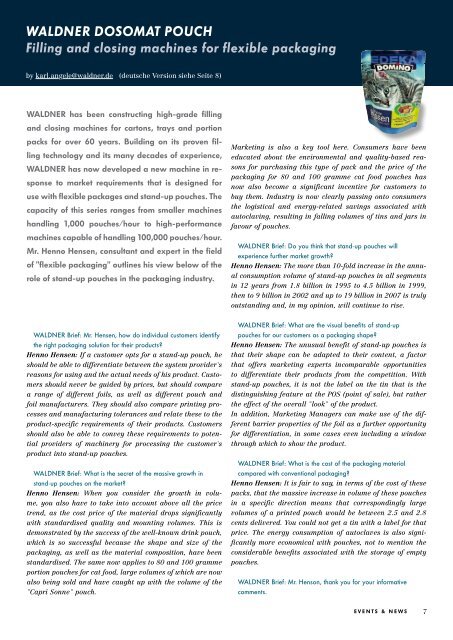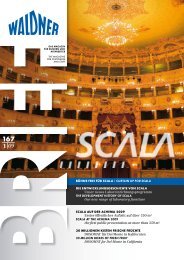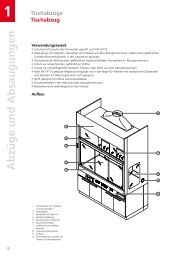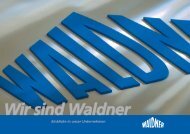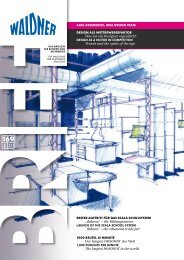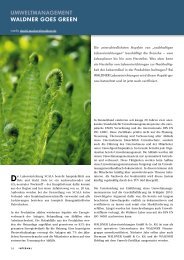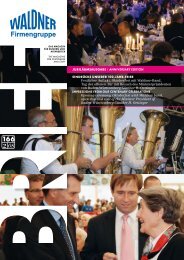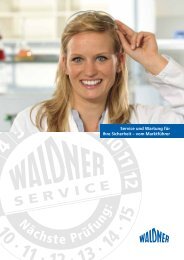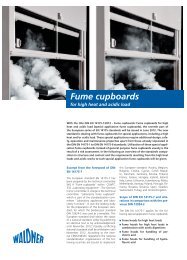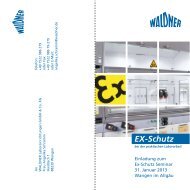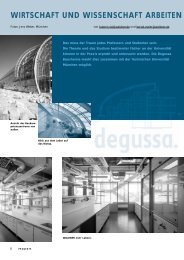WALDNER Brief - Nr. 172.pdf - Waldner Firmengruppe
WALDNER Brief - Nr. 172.pdf - Waldner Firmengruppe
WALDNER Brief - Nr. 172.pdf - Waldner Firmengruppe
Sie wollen auch ein ePaper? Erhöhen Sie die Reichweite Ihrer Titel.
YUMPU macht aus Druck-PDFs automatisch weboptimierte ePaper, die Google liebt.
<strong>WALDNER</strong> DOSOMAT POUCH<br />
Filling and closing machines for flexible packaging<br />
by karl.angele@waldner.de (deutsche Version siehe Seite 8)<br />
<strong>WALDNER</strong> has been constructing high-grade filling<br />
and closing machines for cartons, trays and portion<br />
packs for over 60 years. Building on its proven filling<br />
technology and its many decades of experience,<br />
<strong>WALDNER</strong> has now developed a new machine in response<br />
to market requirements that is designed for<br />
use with flexible packages and stand-up pouches. The<br />
capacity of this series ranges from smaller machines<br />
handling 1,000 pouches/hour to high-performance<br />
machines capable of handling 100,000 pouches/hour.<br />
Mr. Henno Hensen, consultant and expert in the field<br />
of "flexible packaging" outlines his view below of the<br />
role of stand-up pouches in the packaging industry.<br />
<strong>WALDNER</strong> <strong>Brief</strong>: Mr. Hensen, how do individual customers identify<br />
the right packaging solution for their products?<br />
Henno Hensen: If a customer opts for a stand-up pouch, he<br />
should be able to differentiate between the system provider's<br />
reasons for using and the actual needs of his product. Customers<br />
should never be guided by prices, but should compare<br />
a range of different foils, as well as different pouch and<br />
foil manufacturers. They should also compare printing processes<br />
and manufacturing tolerances and relate these to the<br />
product-specific requirements of their products. Customers<br />
should also be able to convey these requirements to potential<br />
providers of machinery for processing the customer's<br />
product into stand-up pouches.<br />
<strong>WALDNER</strong> <strong>Brief</strong>: What is the secret of the massive growth in<br />
stand-up pouches on the market?<br />
Henno Hensen: When you consider the growth in volume,<br />
you also have to take into account above all the price<br />
trend, as the cost price of the material drops significantly<br />
with standardised quality and mounting volumes. This is<br />
demonstrated by the success of the well-known drink pouch,<br />
which is so successful because the shape and size of the<br />
packaging, as well as the material composition, have been<br />
standardised. The same now applies to 80 and 100 gramme<br />
portion pouches for cat food, large volumes of which are now<br />
also being sold and have caught up with the volume of the<br />
"Capri Sonne" pouch.<br />
Marketing is also a key tool here. Consumers have been<br />
educated about the environmental and quality-based reasons<br />
for purchasing this type of pack and the price of the<br />
packaging for 80 and 100 gramme cat food pouches has<br />
now also become a significant incentive for customers to<br />
buy them. Industry is now clearly passing onto consumers<br />
the logistical and energy-related savings associated with<br />
autoclaving, resulting in falling volumes of tins and jars in<br />
favour of pouches.<br />
<strong>WALDNER</strong> <strong>Brief</strong>: Do you think that stand-up pouches will<br />
experience further market growth?<br />
Henno Hensen: The more than 10-fold increase in the annual<br />
consumption volume of stand-up pouches in all segments<br />
in 12 years from 1.8 billion in 1995 to 4.5 billion in 1999,<br />
then to 9 billion in 2002 and up to 19 billion in 2007 is truly<br />
outstanding and, in my opinion, will continue to rise.<br />
<strong>WALDNER</strong> <strong>Brief</strong>: What are the visual benefits of stand-up<br />
pouches for our customers as a packaging shape?<br />
Henno Hensen: The unusual benefit of stand-up pouches is<br />
that their shape can be adapted to their content, a factor<br />
that offers marketing experts incomparable opportunities<br />
to differentiate their products from the competition. With<br />
stand-up pouches, it is not the label on the tin that is the<br />
distinguishing feature at the POS (point of sale), but rather<br />
the effect of the overall "look" of the product.<br />
In addition, Marketing Managers can make use of the different<br />
barrier properties of the foil as a further opportunity<br />
for differentiation, in some cases even including a window<br />
through which to show the product.<br />
<strong>WALDNER</strong> <strong>Brief</strong>: What is the cost of the packaging material<br />
compared with conventional packaging?<br />
Henno Hensen: It is fair to say, in terms of the cost of these<br />
packs, that the massive increase in volume of these pouches<br />
in a specific direction means that correspondingly large<br />
volumes of a printed pouch would be between 2.5 and 2.8<br />
cents delivered. You could not get a tin with a label for that<br />
price. The energy consumption of autoclaves is also significantly<br />
more economical with pouches, not to mention the<br />
considerable benefits associated with the storage of empty<br />
pouches.<br />
<strong>WALDNER</strong> <strong>Brief</strong>: Mr. Henson, thank you for your informative<br />
comments.<br />
Events & News<br />
7


